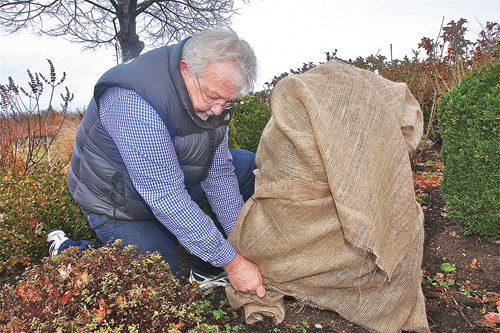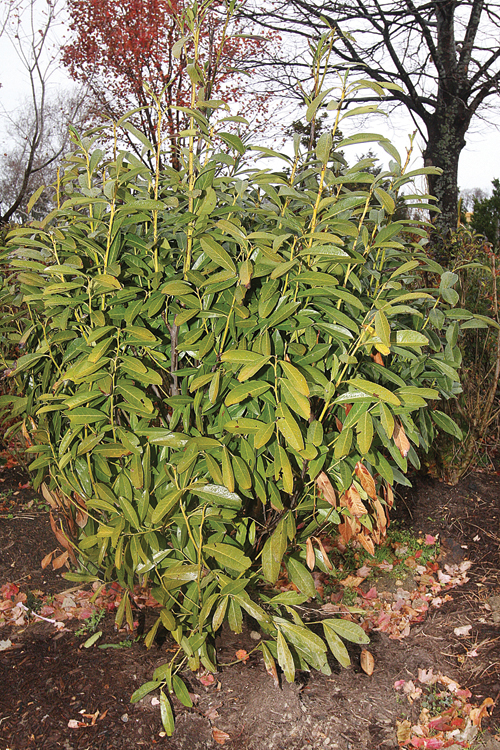Real Estate: Preparing your yard for the deep freeze

As temperatures continue to drop along with the falling leaves, safeguarding gardens and shrubs from the weather becomes the task at hand for many homeowners.
While many think picking up those fallen leaves is a good place to start, area experts say otherwise.
“Protecting the root system is most critical in the winter,” said Dave Cichanowicz, a member of the Southold Town tree committee and president of Creative Environmental Design of Peconic.
One way to protect plant roots is to use those fallen leaves as insulation, helping keep moisture in the ground, he said. He recommends using a mix of mulch and leaves.
“People want to have pristine, clean-looking gardens, so mulching is probably the best way to keep it nice while protecting the root systems,” Mr. Cichanowicz said.
Nancy Gilbert, Riverhead resident and former master gardener with Cornell Cooperative Extension of Suffolk County, said homeowners should also water their plants and shrubs until the ground freezes, because the fall season has been very dry.

Since September, the National Weather Service reports that only 2.75 inches of rain have fallen at the area’s closest official measuring station, in Islip – and the difference between that and what’s fallen on the North Fork is not significant. In contrast, the average rainfall for our area from September through mid-November is 9.86 inches.
Ensuring that moisture remains in the ground through the colder months will help protect plants from winter burn, when the combination of high winds and low moisture causes them to dry out, said Chris Mohr, a landscaping expert in Cutchogue.
Wind burn occurs most commonly in plants that do not lose their foliage, such as the Leyland cypress, blue spruce, cedar trees and junipers, Mr. Mohr said.
Mr. Cichanowicz said once roots are well-watered and insulated, homeowners can protect trees and shrubs by wrapping them in burlap -— starting about this time each year.
“The idea of the wrap is to protect the foliage, keeping the cold wind out of the plant,” Mr. Cichanowicz said.
Winter burn is most common in locations near Long Island Sound, which feel the harsher effects of arctic winter winds coming from the northwest, Mr. Cichanowicz said
While burlap wrap can be applied in many different ways, Mr. Cichanowicz said a basic method starts with laying the burlap over the top of the tree or bush, then wrapping each end as far around the sides as possible. To secure the burlap, he uses a screwdriver to poke holes into different areas of the material and then ties it down with zip ties.
“You want the wrap to [hold] in 30 mph to 40 mph winds,” he said, which means homeowners need to be sure wraps are fitted securely.
Burlap, available through landscaping suppliers as well as local home and garden centers, is often sold in rolls or by the yard, said Kim Talmage of Talmage Farm Agway in Riverhead.
She said she recommends medium bulk burlap, which sells from $1.49 to $2.99 a yard at the Riverhead store.
Homeowners who see wrapping trees and shrubs as too much work should think about applying an anti-dessicant to help keep moisture in a plant, Mr. Mohr said.
“It’s actually an oil that gets sprayed on the plant to prevent the wind from sucking the moisture out,” he said.
When spraying plants, the temperature must be between 28 and 35 degrees – and the later in the season the spray is applied the longer it will last, he said.
“Most customers only want to pay for one spraying, so we try to spray between Thanksgiving and Christmas, which will last until March depending on Mother Nature’s mood,” Mr. Mohr said.
The spray is a good way to enjoy the look of evergreens throughout the winter, Mr. Cichanowicz said, but he added that it will not work for all types of plants.
Shrubs like cherry and skip laurels, which have large, loose foliage, should be wrapped because high winds can strip them of all greenery, leaving them at even greater risk of wind burn, he said.








